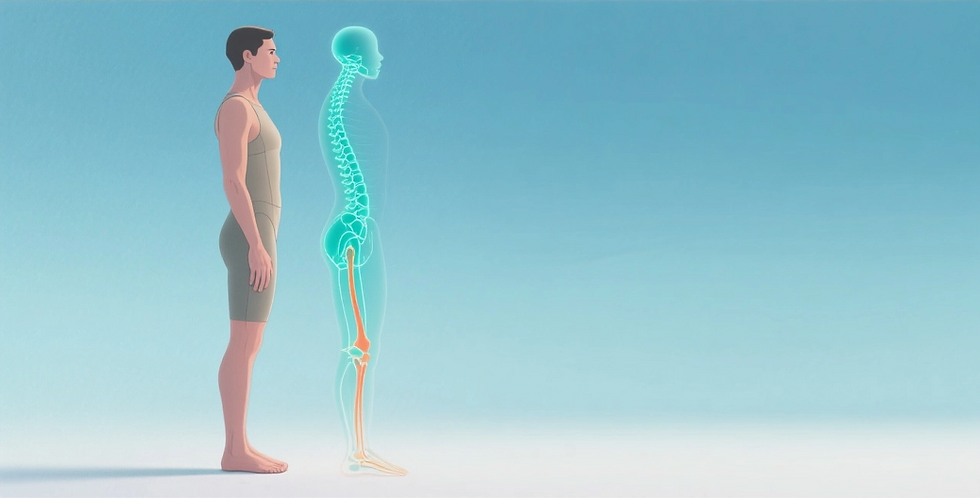What is the Connection Between Fallen Arches and the Rise in Joint Replacements?
- Luc

- Dec 21, 2024
- 3 min read
Updated: Feb 3

In recent years, there has been a remarkable increase in the number of hip and knee replacements among younger individuals. Traditionally, these surgeries were more common in older adults, but recent research highlights a growing trend among people under the age of 65. According to the Wall Street Journal, the number of patients aged 45 to 64 undergoing joint replacements has risen by an astounding 200% over the past two decades. Specifically, between 2000 and 2017, hip replacements in this age group increased by 211%, while knee replacements surged by 240%.
This trend raises important questions about the causes behind the rise in joint replacements and the role of foot health—particularly fallen arches—in contributing to joint stress and pain.
Causes of the Rise in Joint Replacements
Several factors contribute to the increasing number of joint replacements among younger individuals:
1. Active Lifestyles
Younger people are leading more active lives, engaging in high-impact activities such as running, sports, and fitness routines. While these activities are beneficial for overall health, they can place significant stress on the joints, leading to wear and tear, early-onset arthritis, and eventually the need for surgical intervention.
2. Overweight and Obesity
The rising prevalence of obesity is a major factor. Over 40% of American adults are classified as obese, and excess body weight places immense pressure on the joints. For every additional kilogram of body weight, approximately 4 kilograms of extra force is exerted on the joints, accelerating wear and tear.
3. Poor Footwear
Wearing poorly fitting or unsuitable shoes, such as high heels, can contribute to foot problems like fallen arches. Inadequate footwear fails to provide proper support for the feet, leading to poor posture and increased stress on the joints.
4. Weak Muscles
Weak muscles in the feet and legs reduce stability and support, which can exacerbate joint problems. This lack of support often contributes to the development of fallen arches and other foot-related issues.
Fallen Arches: A Common Problem
Fallen arches, or flat feet, are a widespread issue that can lead to discomfort and complications throughout the body. When the arch of the foot collapses, it alters posture and walking mechanics, creating abnormal stress patterns on the muscles and joints.
Common Complaints Associated with Fallen Arches:
Tired Feet: Improper weight distribution causes the foot muscles to fatigue quickly.
Muscle and Joint Pain: The muscles in the legs and feet must work harder, leading to discomfort and pain.
Tendon Issues: Overloading the tendons can result in inflammation or injuries.
Solutions and Treatments
Fortunately, there are effective solutions for both joint replacements and fallen arches. Here are some recommendations:
1. Orthopedic Insoles by Posturepro
Custom orthopedic insoles can help maintain proper foot alignment, reduce stress on the joints, and alleviate symptoms of fallen arches.
2. Physical Therapy
Physical therapy is highly effective for recovery after joint replacement surgery and for strengthening muscles in cases of fallen arches. A tailored therapy plan can improve mobility, reduce pain, and prevent further complications.
3. Shoe Recommendations
Wearing well-fitting shoes with adequate support is essential for joint and foot health. Avoid high heels and opt for footwear that stimulates and strengthens foot muscles, such as minimalist shoes.
4. Exercises
Specific exercises can strengthen the muscles in the feet and legs, improve flexibility, and support overall joint health. These exercises are particularly beneficial for individuals with fallen arches.
Take Action for Better Foot and Joint Health
If you have questions about joint replacements or need help strengthening your fallen arches, I’m here to help. Fallen arches can cause discomfort and complications if not properly addressed, but with the right guidance, you can take steps to improve your foot health and overall well-being.
How I Can Help:
Personalized exercises to strengthen your arches and improve flexibility.
Footwear recommendations tailored to your needs.
Lifestyle tips to reduce joint stress and prevent further complications.
Your foot health is important, and I’m here to support you every step of the way. Feel free to contact me for advice and personalized guidance.
Conclusion
The rise in joint replacements among younger individuals and the prevalence of fallen arches are significant health concerns that require attention. By taking preventive measures—such as wearing appropriate footwear, strengthening foot muscles, and seeking professional advice—you can protect your joints and improve your quality of life.
Disclaimer:
This blog post is for informational purposes only and reflects my personal perspective on the topic. It is not intended as medical advice.
This blog post is for informational purposes only and reflects my personal perspective on the topic. It is not intended as medical advice. I encourage you to do your own research because your mental and physical health and well-being are your own responsibility.





Comments